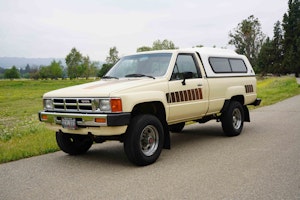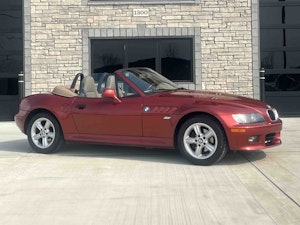Media | Articles
Collecting Japanese cars – where is the market going?
In the world of classic cars, some cars develop a value far in excess of their simple components. For many years, early Ferraris were prized by a few, but values remained reasonable for many who really wanted one. In the 1980s Porsche 356s were affordable for students wanting a fun weekend project and, similarly, long-hood 911s were generally attainable until a few short years ago. Some Cobras were also actually nearly affordable for a short time. But in an increasing manner classics are overriding their usual second-hand car virtues, and obtain a value mostly driven by a vague set of rules.
While not seeking to attempt an accurate definition of what makes one classic car more desirable than another, we can easily conclude that Japanese cars – until recently neglected by enthusiasts and collectors outside of Japan – are now becoming more sought after and accordingly more valuable.
The reasons behind the specific cars’ appreciation vary but, for starters, the ever-increasing prices of European and American classics have driven up prices on formerly attainable, and often overlooked, cars. Additionally, as the United States’ 25-year import rule marches forward, one of the largest classic car markets in the world has set its desires on previously neglected or obscure Japanese machines.
Notable too, some interesting Japanese cars are now starting to trip this threshold and have recently seen an increase in both general driver attraction and the corresponding interest in collector interests, too.
So what Japanese kyusha (classic car), should enthusiasts be looking at? To date, the top-tier Japanese collectible has been the $1M-plus Toyota 2000GT. Only a few short years ago, a $300,000 drivers’ car, it has very quickly moved into the investors’ and collectors’ domain. Nissan ‘Hakosuka’ GT-Rs from the late 1960s too have increased three-fold in price to hundreds of thousand dollars. But, what below these stratospherically valued Japanese cars can a driving enthusiast still enjoy?
Marketplace
Buy and sell classics with confidence
The next car likely to enjoy substantial price increases is the already appreciating (and costly) rotary marvel, the Mazda Cosmo Sports. Hand-built in low numbers, the first short wheelbase model is sure to be prized by collectors.
Nissan’s Fairlady Z432, equipped with the famous S20 twin-cam engine from the ‘Hakosuka’ GT-R is a valuable car, but perhaps dragged down by its visual similarity to the garden variety 240Z. The ‘G-Nosed’ Fairlady of the same era, with their aerodynamic face and aggressive fenders will find appeal too, at least in the Japanese market.
While the rev-happy Honda S600 and S800 are moderately well known in the US, the first large-scale release version – the S500 – is practically unknown outside of Japan. While the S600 and S800 will slowly increase in value, the S500 is already a collector’s car. Although the early model’s foibles make it a difficult and sometimes unreliable driver, their low production numbers ensure their collector status. Consequently, their valuations already exceed the market price of a comparable S600 or S800 by two or three times in Japan.
Almost unknown outside of Japan and Australia, are the Prince Skyline GT-A and GT-B. Prince, soon to become Nissan under a government decree, took their standard passenger saloon, and stuffed a big six-cylinder engine in it, bolted on a set of triple side draught Weber carbs, and went racing. The Skyline GT racing legend was then born with the 1966 Japanese Grand Prix, when the newly configured racing Skyline took the lead over a Porsche 904. Class wins in Australia’s premier long-distance race at Bathurst, further cemented its racing credentials.
Staying in the Nissan family, the lithe, exotic, and Bertone-designed first generation Silvia was Nissan’s attempt at a gentleman’s touring machine. With only a few hundred built, their collector value is guaranteed. As a driver’s car, they find appeal notable too, as their running gear is essentially the same as the Datsun Sports of the same year.
Time will tell which kyusha will find attraction to drivers and collectors alike, but further down the tree there are a number that are likely to find universal appeal. They include: The diminutive, mostly aluminum-bodied Toyota Sports 800, and though from mundane shopping cart roots, the racing Toyota twin-cams of the Corolla Levin and Corona 1600GT. The last one, equipped with Yamaha-built racing heads like its more valuable sister the 2000GT.
If you really want to be exotic, the rally prepared Isuzu Bellett Type-R made history across the Asian Pacific in numerous period rallies and still finds favor in the modern age in classic rallies. Isuzu’s Giugiaro-designed 117 Coupe grand tourer, though lacking any competition history is a beautiful machine to look at, and the low-volume hand-made first series are sure to become collector cars.
From Mitsubishi’s vast early competition history, the grandfather of the Evo series, the Gallant GTO and FTO may similarly find appeal.
From more modern times, the Nissan Figaro will be sure to maintain its quirky appeal. Perhaps not for any reason other than their oh-so-cute looks. Similarly, the so-called ABCs of the kei-car world: The AZ-1, Beat and Cappucino (built by Autozam (a division of Mazda), Honda and Suzuki respectively) may also become attractive if only because of their modern-day usability with great economy, and nimble handling.
In selecting a classic Japanese car for either general driving or collecting, the same simple rules applied to European exotica and American muscle also apply: was it made in limited numbers, does it have a competition history, and subjectively perhaps, is it beautiful to look at? While we cannot tell with any certainty which model kyusha will appreciate over others, we can be certain that Japanese cars will continue to increase in desirability and value.
Which one will you buy?
—
Kuro Neko is a Japan-based photographer and a regular contributor to Japanese Nostalgic Car, and is a partner for the carsonfilm.tumblr.com blog











i just stumbled on this article and the lead photo of the CSP311 silvia is fantastic! Any clue who shot it or if there are additional photos in the series?
It was shot by me on film outside Okutama-ko, and you can find more on the sites mentioned…
Ran into this article as well. On the more mundane, utilitarian side of things, I just picked up a 1999 Camry with only 18k miles! I think it’s going to have a date with BaT!